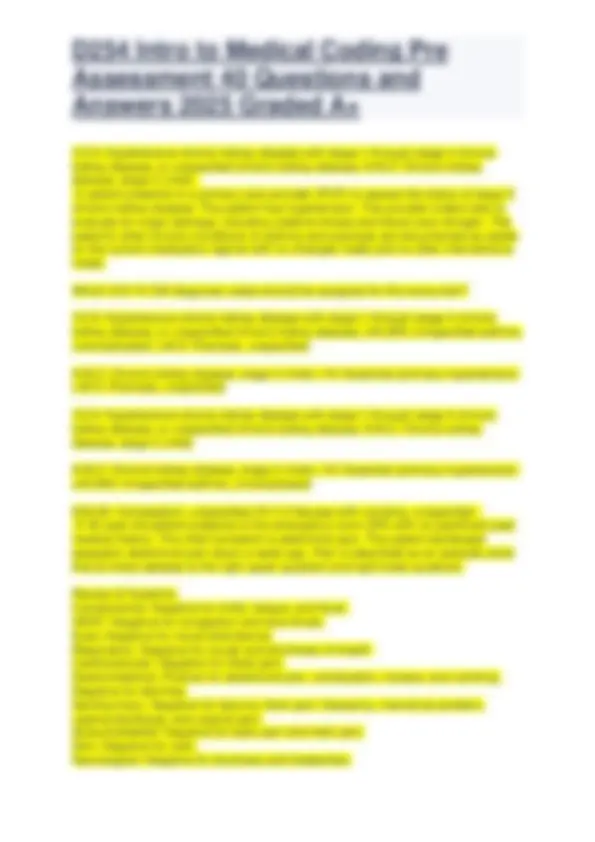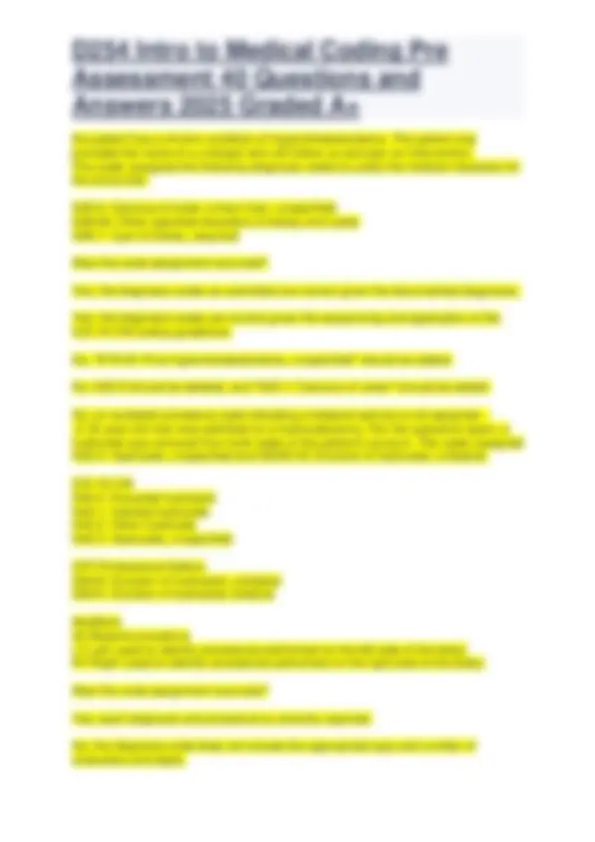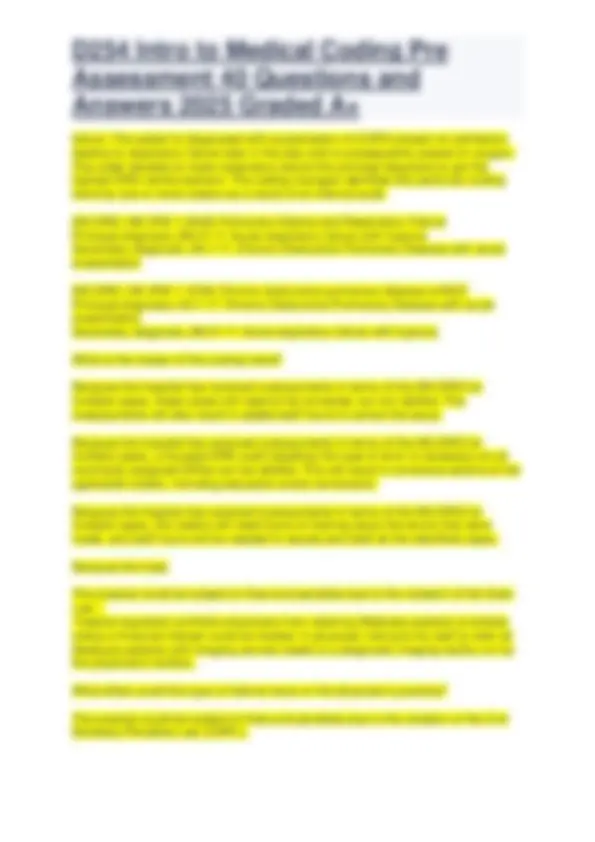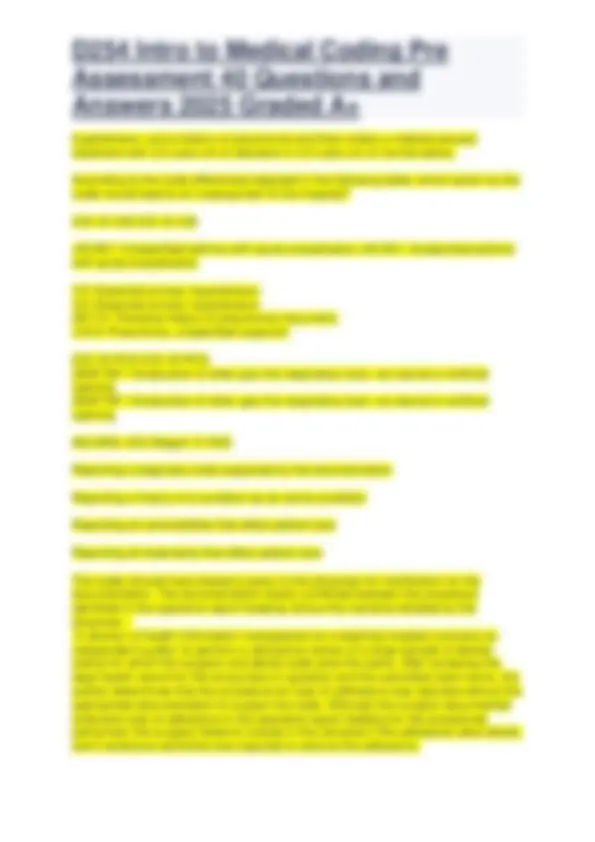
















Study with the several resources on Docsity

Earn points by helping other students or get them with a premium plan


Prepare for your exams
Study with the several resources on Docsity

Earn points to download
Earn points by helping other students or get them with a premium plan
Community
Ask the community for help and clear up your study doubts
Discover the best universities in your country according to Docsity users
Free resources
Download our free guides on studying techniques, anxiety management strategies, and thesis advice from Docsity tutors
D254 Intro to Medical Coding Pre Assessment 40 Questio
Typology: Exams
1 / 22

This page cannot be seen from the preview
Don't miss anything!















42826: Tonsillectomy, primary or secondary; age 12 or over - A 32-year-old patient was admitted to outpatient surgery for primary tonsillectomy. The tonsils were grasped with a tool and removed. Which CPT code is assigned for this procedure? 42821: Tonsillectomy and adenoidectomy, primary or secondary; age 12 or over 42826: Tonsillectomy, primary or secondary; age 12 or over 42842: Radical resection of tonsil, tonsillar pillars and/or retromolar trigone; without closure 42870: Excision or destruction lingual tonsil, any method (separate procedure) 31254 - 50: Nasal/sinus endoscopy, surgical with ethmoidectomy; partial (anterior) - A 67-year-old patient with sinus issues presented to outpatient surgery for an ethmoidectomy. Per the procedure note, the patient's anterior ethmoid sinuses were removed bilaterally via endoscopic approach. Which CPT code is assigned for this procedure? 31200 - 50: Ethmoidectomy; intranasal, anterior 31201 - 50: Ethmoidectomy; intranasal, total 31254 - 50: Nasal/sinus endoscopy, surgical with ethmoidectomy; partial (anterior) 31255 - 50: Nasal/sinus endoscopy, surgical with ethmoidectomy; total (anterior and posterior) 65450 - RT (Right): Destruction of lesion of cornea by cryotherapy, photocoagulation or thermocauterization - A patient presents to a physician's office complaining of discomfort in the right eye. The examination concludes there is a lesion on the cornea with chronic inflammation of the epithelium tissue. The physician uses cold therapy to remove the corneal lesion of the right eye. Which CPT code should be assigned for this procedure? 65400 - RT (Right): Excision of lesion, cornea (keratectomy, lamellar, partial), except pterygium
65435 - RT (Right): Removal of corneal epithelium; with or without chemocauterization (abrasion, curettage) 65436 - RT (Right): Removal of corneal epithelium; with application of chelating agent (e.g., EDTA) 65450 - RT (Right): Destruction of lesion of cornea by cryotherapy, photocoagulation or thermocauterization 25111 - RT (Right): Excision of ganglion, wrist (dorsal or volar); primary - A 16-year-old patient presents for a preoperative consultation for a right ganglion cyst. The surgeon performed a right volar ganglion cyst excision. A transverse incision was made overlying the cyst with sharp dissection through the skin. Tenotomy scissors and retractors were used in combination with bipolar electrocautery to free the cyst of the surrounding structures. Which CPT code should be assigned for this procedure? 25000 - RT (Right): Incision, extensor tendon sheath, wrist (eg, de Quervain's disease) 25001 - RT (Right): Incision, flexor tendon sheath, wrist (eg, flexor carpi radialis) 25111 - RT (Right): Excision of ganglion, wrist (dorsal or volar); primary 25112 - RT (Right): Excision of ganglion, wrist (dorsal or volar); recurrent A4000-A4899: Medical and Surgical Supplies - A patient was admitted with a ruptured appendix and taken into surgery. At the time of the appendectomy, a suspicious nodule at the head of the pancreas was observed. A needle biopsy was performed while the abdomen was open. Which section of the HCPCS Level II code set includes the code for the needle biopsy supplies? A4000-A4899: Medical and Surgical Supplies G0000-G9999: Procedures/Professional Services (Temporary) M0000-M0009: Medical Services P2000-P2999: Laboratory Tests C1785: Pacemaker, dual chamber, rate-responsive (implantable) - A patient with a history of congestive heart failure presents to the emergency room complaining of shortness of breath and chest pains. A cardiac electrophysiologist implants an activity-sensing pacemaker in the chest, generating electric impulses to
I12.9: Hypertensive chronic kidney disease with stage 1 through stage 4 chronic kidney disease, or unspecified chronic kidney disease; N18.2: Chronic kidney disease, stage 2 (mild) - A patient presents to a primary care provider (PCP) to assess the status of stage 2 chronic kidney disease. The patient has hypertension. The provider orders labs to evaluate for organ damage, including creatine kinase and blood urea nitrogen. The patient's other chronic conditions of asthma and psoriasis are documented as stable on the current medication regime with no changes made and no other interventions noted. Which ICD- 10 - CM diagnosis codes should be assigned for this encounter? I12.9: Hypertensive chronic kidney disease with stage 1 through stage 4 chronic kidney disease, or unspecified chronic kidney disease; J45.909: Unspecified asthma, uncomplicated; L40.9: Psoriasis, unspecified N18.2: Chronic kidney disease, stage 2 (mild); I10: Essential (primary) hypertension; L40.9: Psoriasis, unspecified I12.9: Hypertensive chronic kidney disease with stage 1 through stage 4 chronic kidney disease, or unspecified chronic kidney disease; N18.2: Chronic kidney disease, stage 2 (mild) N18.2: Chronic kidney disease, stage 2 (mild); I10: Essential (primary) hypertension; J45.909: Unspecified asthma, uncomplicated K59.00: Constipation, unspecified; R11.2 Nausea with vomiting, unspecified - A 45-year-old patient presents to the emergency room (ER) with no significant past medical history. The chief complaint is abdominal pain. The patient developed epigastric abdominal pain about a week ago. Pain is described as an episodic ache that at times radiates to the right upper quadrant and right lower quadrant. Review of Systems: Constitutional: Negative for chills, fatigue, and fever. HENT: Negative for congestion and sore throat. Eyes: Negative for visual disturbance. Respiratory: Negative for cough and shortness of breath. Cardiovascular: Negative for chest pain. Gastrointestinal: Positive for abdominal pain, constipation, nausea, and vomiting. Negative for diarrhea. Genitourinary: Negative for dysuria, flank pain, frequency, menstrual problem, vaginal discharge, and vaginal pain. Musculoskeletal: Negative for back pain and neck pain. Skin: Negative for rash. Neurological: Negative for dizziness and headaches.
Hematological: Negative for adenopathy. All other systems reviewed and are negative. Final Clinical Impression: Constipation, and Epigastric abdominal pain. What are the ICD- 10 - CM diagnosis codes for this encounter? K59.00: Constipation, unspecified; R11.2 Nausea with vomiting, unspecified R10.9: Unspecified abdominal pain; R11.2 Nausea with vomiting, unspecified R10.11: Right upper quadrant pain; R10.31 Right lower quadrant pain R10.13: Epigastric Pain; R10.84 Generalized abdominal pain J45.901: Unspecified asthma with (acute) exacerbation - A 16-year-old patient complains of difficulty breathing, chest pressure, and a moderate dry cough. The patient has not experienced any of the recorded symptoms previously. The chest X-ray reveals acute pulmonary edema. Oxygen is provided until the patient is stable. The patient is prescribed albuterol and discharged home. The clinical findings conclude extrinsic asthma with acute exacerbation. Which ICD- 10 - CM diagnosis code should be assigned for this encounter? J45.41: Moderate persistent asthma with (acute) exacerbation J45.42: Moderate persistent asthma with status asthmaticus J45.901: Unspecified asthma with (acute) exacerbation J45.902: Unspecified asthma with status asthmaticus C61: Malignant neoplasm of the prostate - A patient is admitted to an ambulatory surgery center at a hospital and undergoes transurethral resection of the prostate for benign prostatic hypertrophy. The patient had a documented rising prostate-specific antigen and lower urinary tract symptoms of urinary frequency and urgency. The pathology report is positive for adenocarcinoma of the prostate. What is the first-listed ICD- 10 - CM diagnosis code for this encounter? C61: Malignant neoplasm of the prostate N40.0: Benign prostatic hypertrophy N40.1: Benign prostatic hyperplasia with lower urinary tract symptoms R35.0: Urinary frequency
0VT04ZZ: Resection of prostate, percutaneous endoscopic approach 8E0W4CZ: Other procedure, trunk region, percutaneous endoscopic approach, robotic assisted procedure - A 67-year-old male with prostate cancer is scheduled for a robotic-assisted laparoscopic prostatectomy. In the surgical suite, the surgeon made an extension to the initial incision to assist in the removal of the entire prostate. Which ICD- 10 - PCS codes are assigned for this procedure? 0VB04ZZ: Excision of prostate, percutaneous endoscopic approach 8E0W0CZ: Other procedure, trunk region, open, robotic assisted procedure 0VB04ZZ: Excision of prostate, percutaneous endoscopic approach 8E0W3CZ: Other procedure, trunk region, percutaneous approach, robotic assisted procedure 0VT00ZZ: Resection of prostate, open approach 8E0W3CZ: Other procedure, trunk region, percutaneous approach, robotic assisted procedure 0VT04ZZ: Resection of prostate, percutaneous endoscopic approach 8E0W4CZ: Other procedure, trunk region, percutaneous endoscopic approach, robotic assisted procedure 0HTV0ZZ; 0HRV0JZ - A 45-year-old female diagnosed with breast cancer is admitted to the hospital for a bilateral total mastectomy followed by reconstruction with a synthetic substitute. Use the codes in the following table to identify which codes to assign for this scenario. ICD- 10 - PCS Code Code Description 0HBT0ZZ Excision of Right Breast, Open Approach 0HBU0ZZ Excision of Left Breast, Open Approach 0HBV0ZZ Excision of Bilateral Breast, Open Approach 0HRT0JZ Replacement of Right Breast, Open Approach, with Synthetic Substitute 0HRU0JZ Replacement of Left Breast, Open Approach, with Synthetic Substitute 0HRU0KZ Replacement of Left Breast, Open Approach, with Nonautologous Tissue Substitute 0HRV0KZ Replacement of Bilateral Breast, Open Approach, with Nonautologous Tissue Substitute 0HRV0JZ Replacement of Bilateral Breast, Open Approach, with Synthetic Substitute 0HTV0ZZ Resection of Bilateral Breast, Open Approach Which ICD- 10 - PCS codes are assigned for this procedure? 0HBT0ZZ; 0HBU0ZZ; 0HRV0KZ 0HBU0ZZ; 0HRV0KZ
0X6C0ZZ: Medical and surgical, anatomical regions, upper extremities, detachment, elbow region, left, open - A diabetic patient presents at a hospital with increasing complaints of a painful left hand with skin discoloration, swelling, and smelly discharge extending directly below the antecubital fossa region. The patient is not responding as expected to medical management of intravenous antibiotics. The left lower arm infection is gangrenous. The magnetic resonance imaging (MRI) shows osteomyelitis. An orthopedic surgeon recommends surgery for disarticulation of the elbow joint. Which ICD- 10 - PCS code should be assigned for this procedure? 0XBC0ZZ: Medical and surgical, anatomical regions, upper extremities, excision, elbow region, left, open 0XBF0ZZ: Medical and surgical, anatomical regions, upper extremities, excision, lower arm, left, open 0X6C0ZZ: Medical and surgical, anatomical regions, upper extremities, detachment, elbow region, left, open 0X6F0ZZ: Medical and surgical, anatomical regions, upper extremities, detachment, lower arm, left, open 5A1945Z; 0BH18EZ - A patient is brought to the emergency department (ED) by an ambulance after being found on the floor. Per the emergency medical services (EMS) report, the patient had a blank stare that lasted a few seconds. A stroke code is called, and the patient is admitted with inpatient status to the hospital on Tuesday. The patient's arterial blood gases (ABGs) are taken, which show a partial pressure of arterial carbon dioxide (PaCO2) of 67 mmHg. At 9:16 p.m., the attending physician proceeds to intubate the airways by using a video laryngoscope. The patient is diagnosed with acute hypercapnic respiratory failure and kept on mechanical ventilation until Thursday of the same week. The patient is extubated from ventilation at 7:15 p.m. Thursday and is breathing on room air adequately. Use the ICD- 10 - PCS codes in the following table to identify which codes to assign for this scenario. ICD- 10 - PCS Code Code Description 0BH17EZInsertion, trachea, via natural or artificial opening, intraluminal device, endotracheal airway
the patient has a chronic condition of hypercholesterolemia. The patient was provided the name of a urologist who will follow up and plan an intervention. The coder assigned the following diagnosis codes to justify the medical necessity for the encounter: N20.9: Calculus of lower urinary tract, unspecified N28.89: Other specified disorders of kidney and ureter N28.1: Cyst of kidney, acquired Was this code assignment accurate? Yes, the diagnosis codes as submitted are correct given the documented diagnoses. Yes, the diagnosis codes are correct given the sequencing and application of the ICD- 10 - CM coding guidelines. No, "E78.00: Pure hypercholesterolemia, unspecified" should be added. No, N20.9 should be deleted, and "N20.1: Calculus of ureter" should be added. No, an available procedure code indicating a bilateral service is not assigned. - A 33-year-old man was admitted for a hydrocelectomy. Per the operative report, a hydrocele was removed from both sides of the patient's scrotum. The coder assigned N43.3: Hydrocele, unspecified and 55040-50: Excision of hydrocele; unilateral. ICD- 10 - CM N43.0: Encysted hydrocele N43.1: Infected hydrocele N43.2: Other hydrocele N43.3: Hydrocele, unspecified CPT Professional Edition 55040: Excision of hydrocele; unilateral 55041: Excision of hydrocele; bilateral Modifiers 50 Bilateral procedure LT Left (used to identify procedures performed on the left side of the body) RT Right (used to identify procedures performed on the right side of the body) Was this code assignment accurate? Yes, each diagnosis and procedure is correctly reported. No, the diagnosis code does not include the appropriate type and number of characters and digits.
Yes, the appropriate modifier is assigned to the procedure code. No, an available procedure code indicating a bilateral service is not assigned. No, not all codes match the scenario. - A liveborn infant is delivered vaginally in a hospital. Within the newborn examination, the provider documents yellowing of the baby's skin and eyes. The provider orders phototherapy for neonatal hyperbilirubinemia. The following codes are assigned: Z38.00: Single liveborn infant, delivered vaginally R17: Jaundice, unspecified P59.9: Neonatal jaundice, unspecified Is this code assignment accurate? Yes, all codes match the diagnoses provided. Yes, all codes are correct and include the correct number of characters and digits. No, the codes are correctly assigned, but they are not correctly sequenced. No, not all codes match the scenario. No, the signs and symptoms codes for dyspnea and fever should be deleted. The pneumonia was documented to be due to pseudomonas. Acute respiratory failure with hypoxia developed after admission and should be sequenced as a secondary diagnosis. - A facility fee coding auditor is reviewing the encounter documentation and the assigned codes for a patient encounter. A patient presented to the emergency room (ER) with complaints of dyspnea and fever for several days. The patient was subsequently admitted to inpatient status in the hospital for pneumonia. The provider documented the bacterial source as pseudomonas, for which the provider put the patient on IV antibiotics. Three days after admission, the patient went into acute respiratory failure with hypoxia and did not recover despite being placed on a ventilator. The coder assigned the following diagnosis codes to meet medical necessity for the encounter: J15.1: Pneumonia due to pseudomonas J96.01: Acute respiratory failure with hypoxia R06.00: Dyspnea, unspecified R50.9: Fever, unspecified
No, there is a presumed relationship between congestive heart failure and hypertension unless the provider explicitly states that the hypertension is due to another cause. "I10: Essential (primary) hypertension" should be deleted, and "I50.22: Chronic systolic (congestive) heart failure" should be added. Query the attending physician to verify the CHF diagnosis and document the type and acuity of the heart failure. Include in the query the heart failure documentation, the echo results, and the use of carvedilol and furosemide. - A patient was admitted as an inpatient to the hospital for a non-ST elevation myocardial infarction. The patient underwent cardiac catheterization with coronary angiography, which revealed that the patient had 75% occlusion of the right coronary artery. A drug-eluting stent was inserted after an angioplasty. The patient's medical record documents that the patient has congestive heart failure (CHF), but nothing more than CHF is documented. However, the patient is on carvedilol (Coreg) and furosemide (Lasix). An echocardiogram (echo) was performed, revealing a reduced ejection fraction at 35%, which is synonymous with systolic heart failure. Neither the results of the echo nor the specific type of heart failure was documented by the attending physician in the progress notes or discharge summary. What should the coder do? Code chronic systolic heart failure. The ejection fraction was documented as reduced in the echocardiogram, and the physician documentation shows the patient currently has CHF and is on carvedilol and furosemide, which is sufficient to code for this condition. Code CHF, unspecified. Based on the documentation included in the medical records, this is the only diagnosis or procedure information that can be coded. Query the attending physician to verify the CHF diagnosis and document the type and acuity of the heart failure. Include in the query the heart failure documentation, the echo results, and the use of carvedilol and furosemide. Query the attending physician to document chronic systolic heart failure based on the heart failure documentation and echo results as well as the use of carvedilol and furosemide. Speak to the facility manager or the compliance officer to express concern about the lack of feedback on the quality of coding - An independent review organization (IRO) was hired by a skilled nursing facility (SNF) to conduct coding compliance audits as part of a corporate integrity agreement. The IRO submits its findings directly to the chief financial officer. One of the SNF coders is concerned because the individual coders have not received any feedback from the audits.
Which action should the coder take? Speak to the facility manager or the compliance officer to express concern about the lack of feedback on the quality of coding Avoid talking to the manager or compliance officer and enroll in a skilled nursing coding class to improve coding techniques and confidence Resign and immediately report the SNF coding audit concern to the U.S. Department of Health and Human Services (HHS) Office of Inspector General (OIG) as an informant Contact the vendor to ask whether they would send the feedback from the audit results directly to the coder for personal review Notify the HIM manager about the potential SCIP reporting violation so it can be addressed - A hospital's quality department asks a coder, who reports to the health information management (HIM) department manager, for assistance in an area that the department is concerned about. The concern relates to the documentation of venous thromboembolism (VTE) prophylaxis orders for patients undergoing surgery as part of the Surgical Care Improvement Project (SCIP) quality core measures. The quality department asks the coder to audit a selection of surgical cases to see if an order is in the record. After reviewing 25 records, the coder identifies the order is missing in 12 cases, which is significant. The coder reports the findings to the quality department. However, the quality department continues to report these cases as having met the SCIP core measures and states they will, going forward, work with the surgeons to ensure that the orders for VTE are in place. What should the coder do? Notify the HIM manager about the potential SCIP reporting violation so it can be addressed Continue to monitor the situation when coding records on surgical cases Report the issue to the U.S. Department of Health and Human Services (HHS) Demand the quality department to correct the orders rather than report the cases as meeting core measures Query the attending physician to ask if they agree with the diagnosis made by the RD - A medical coder is reviewing a chart where the attending physician documented in the history and physical (H&P) a body mass index (BMI) of 60 on a patient as a
Which action should the coder have taken instead of assigning the code? The coder should have queried the provider to clarify if the pneumonia was ruled based on the clinical indicators and the treatment given and if it was considered a complication due to surgery. The coder should have assigned an adverse effect code from category T41 that specifies the anesthesia administered. The coder should have assigned the unspecified pneumonia code as present on the admission indicator of N. The coder should have followed up with the clinical documentation specialist and advised the provider to document postoperative pneumonia as a complication of surgery after assigning 8.2. Access only that information necessary to perform their duties. - A medical coder works for a private metropolitan area hospital known for having celebrities as patients. The coder comes across an encounter with a recognizable name. The patient is a popular actor who is filming a movie in a town nearby. The coder wants as many details as possible and accesses the actor's demographic tab in the electronic health record system, which includes the residence and mailing address of the actor. Which ethical principle of the AHIMA Standards of Ethical Coding does this violate? 8.1. Protect all confidential information obtained in the course of professional service, including personal, health, financial, genetic, and outcome information. 8.2. Access only that information necessary to perform their duties. 9.1. Utilize all tools, both electronic and hard copy that are available to ensure accurate code assignment. 11.2. Take adequate measures to discourage, prevent, expose, and correct the unethical conduct of colleagues. Diagnosis-related group (DRG) assignments - A 100-bed acute care facility has an inpatient case mix index of 1.4. This is significantly higher than the facility's peers in the same state. What should the coding manager analyze to verify appropriate coding practices? Resource-based relative value scale (RBRVS) assignments Diagnosis-related group (DRG) assignments
Ambulatory payment classification (APC) assignments Ambulatory payment groups (APG) assignments Compare billing and utilization patterns to facilities that have similar bed sizes, patient mix, physician specialty, or types of services provided - What is a way to monitor the case mix index to determine potential coding or billing issues? Compare the inpatient and outpatient coding practices of similar services provided within the same facility Compare billing and utilization patterns to facilities that have similar bed sizes, patient mix, physician specialty, or types of services provided Compare the policies and procedures for coding and reporting to facilities that have similar bed sizes, patient mix, physician specialty, or types of services provided Compare notes with other health information management (HIM) directors on how they handle physicians who are noncompliant with documentation initiatives Over reimbursement - A coder is reviewing a record on a patient admitted to inpatient status for sepsis due to a COVID-19 infection, which was also the final diagnosis. The health information management (HIM) director has instructed the coder that for COVID-19 cases, the COVID-19 diagnosis code should always be reported as the principal diagnosis if it was present on admission. The coder knows that this conflicts with the ICD- 10 - CM Official Guidelines for coding and reporting. Diagnosis codes: U07.1: COVID- 19 (principal diagnosis) A41.89: Other specified sepsis (secondary diagnosis) What will be the impact if the coder follows the HIM director's instructions? Under reimbursement Zero reimbursement Over reimbursement Partial reimbursement The day surgery's ASC reimbursement will be less than what the facility deserves in many cases. - The physicians at a day surgery center sometimes fail to document the size of skin lesions in their procedure notes. Since the coders cannot rely on the nurses' notes or other supporting clinical staff documentation to assign a CPT procedure code, they always assign the CPT code with the shortest length.
failure. The patient is diagnosed with exacerbation of COPD present on admission leading to respiratory failure later in the stay and is subsequently placed on oxygen. The coder decides to make respiratory failure the principal diagnosis to get the highest DRG reimbursement. The coding manager identifies this particular coding trend by one or more coders as a result of an internal audit. MS-DRG 189 (RW 1.2248) Pulmonary Edema and Respiratory Failure Principal diagnosis J96.01-Y: Acute respiratory failure with hypoxia Secondary diagnosis J44.1-Y: Chronic Obstructive Pulmonary Disease with acute exacerbation MS-DRG 194 (RW 1.1239) Chronic obstructive pulmonary disease w/MCC Principal diagnosis J44.1-Y: Chronic Obstructive Pulmonary Disease with acute exacerbation Secondary diagnosis J96.01-Y: Acute respiratory failure with hypoxia What is the impact of this coding trend? Because the hospital has received overpayments in terms of the MS-DRG for multiple cases, these cases will need to be corrected, but not rebilled. The overpayments will also result in added staff hours to correct the issue. Because the hospital has received overpayments in terms of the MS-DRG for multiple cases, a focused DRG audit targeting this type of error is necessary so all incorrectly assigned DRGs can be rebilled. This will result in corrective actions to the applicable coders, including education and/or termination. Because the hospital has received overpayments in terms of the MS-DRG for multiple cases, the coders will need hours of training about the errors that were made, and staff hours will be needed to recode and rebill all the identified cases. Because the hosp The practice could be subject to fines and penalties due to the violation of the Stark Law. - Federal regulation prohibits physicians from referring Medicare patients to entities where a financial interest could be implied. A physician instructs his staff to refer all Medicare patients with imaging service needs to a diagnostic imaging facility run by the physician's brother. What effect could this type of referral have on the physician's practice? The practice could be subject to fines and penalties due to the violation of the Civil Monetary Penalties Law (CMPL).
The practice could be subject to fines and penalties due to the violation of the False Claims Act (FCA). The practice could be subject to fines and penalties due to the violation of the Anti- Kickback Statute (AKS). The practice could be subject to fines and penalties due to the violation of the Stark Law. It reports a principal diagnosis that defines a higher reimbursement rate. - A patient with type 2 diabetes presents to the hospital with syncope. The patient is admitted as an inpatient. The attending physician documents orthostatic hypotension as the reason for admission. In the discharge summary, the discharging physician documents orthostatic hypotension as the principal diagnosis. The discharging physician also documents that the patient probably has autonomic neuropathy due to diabetes. The coder assigns type 2 diabetes mellitus with diabetic autonomic polyneuropathy as the principal diagnosis because the coder knows the hospital will receive a higher reimbursement. The following table represents which codes should have been assigned and which codes were assigned. Why is the incorrect code assignment considered a fraudulent practice? Principal Diagnosis Secondary Diagnosis MS-DRG Weight Correct assignment I951: Orthostatic hypotension E1143: Type 2 diabetes mellitus with diabetic autonomic polyneuropathy Incorrect assignment E1143: Type 2 diabetes mellitus with diabetic autonomic polyneuropathy I951: Orthostatic hypotension It reports a principal diagnosis that defines a higher reimbursement rate. It reports an additional diagnosis that is documented in the medical record. It reports a diagnosis that relates only to documentation. It reports an additional diagnosis that affects the care of the patient. Reporting a history of a condition as an active condition - A 28-year-old patient with a history of asthma is seen by a hospital emergency room physician. The patient complains of acute shortness of breath and has audible wheezing. The patient has been taking her prescribed medication of albuterol inhaler but has had no relief of symptoms. The physician documents asthma exacerbation,